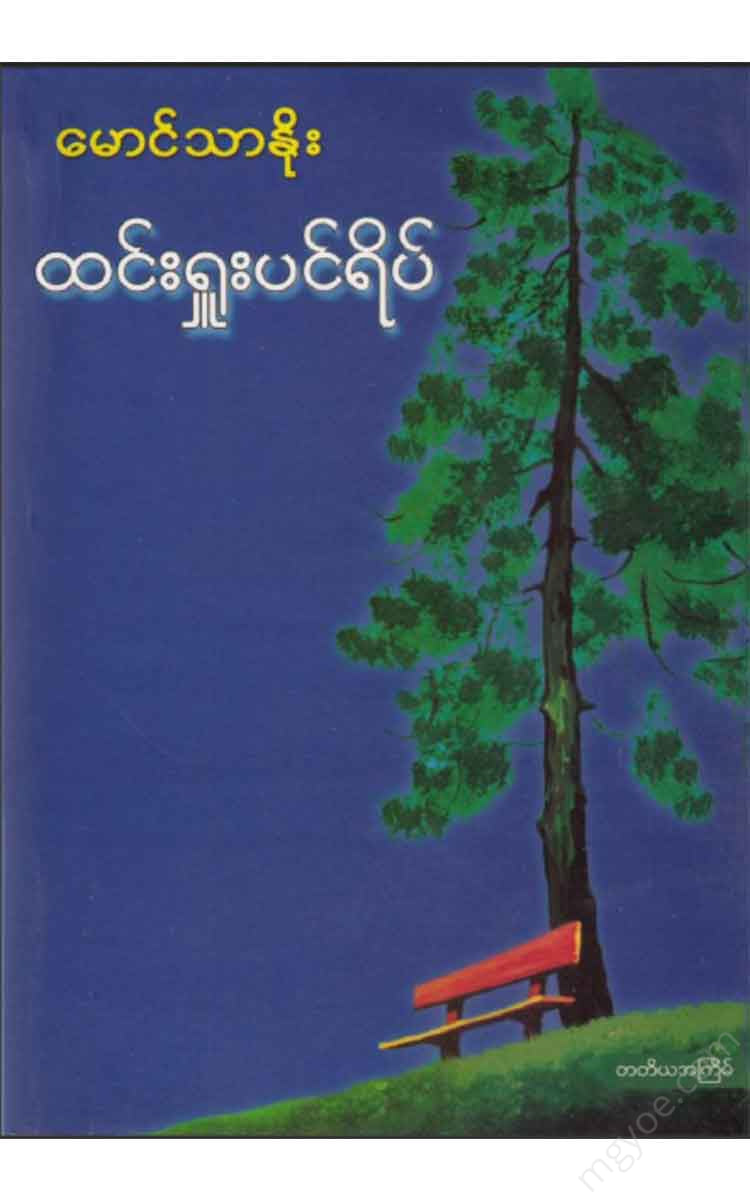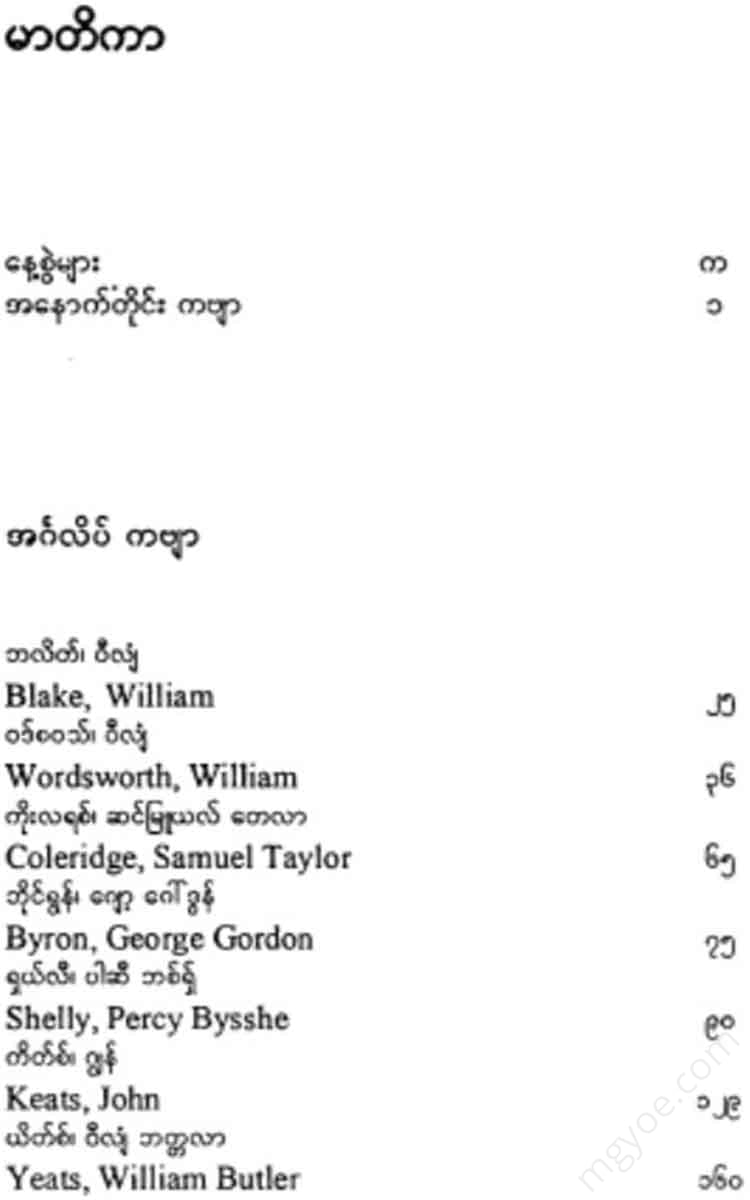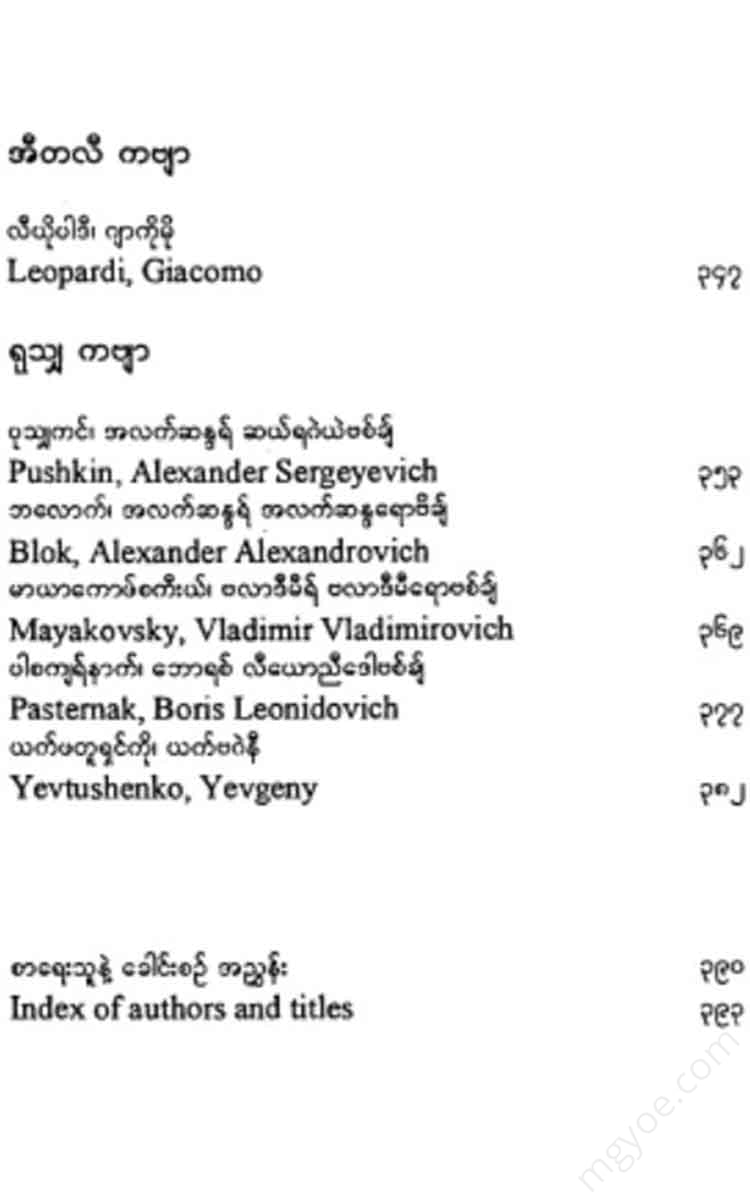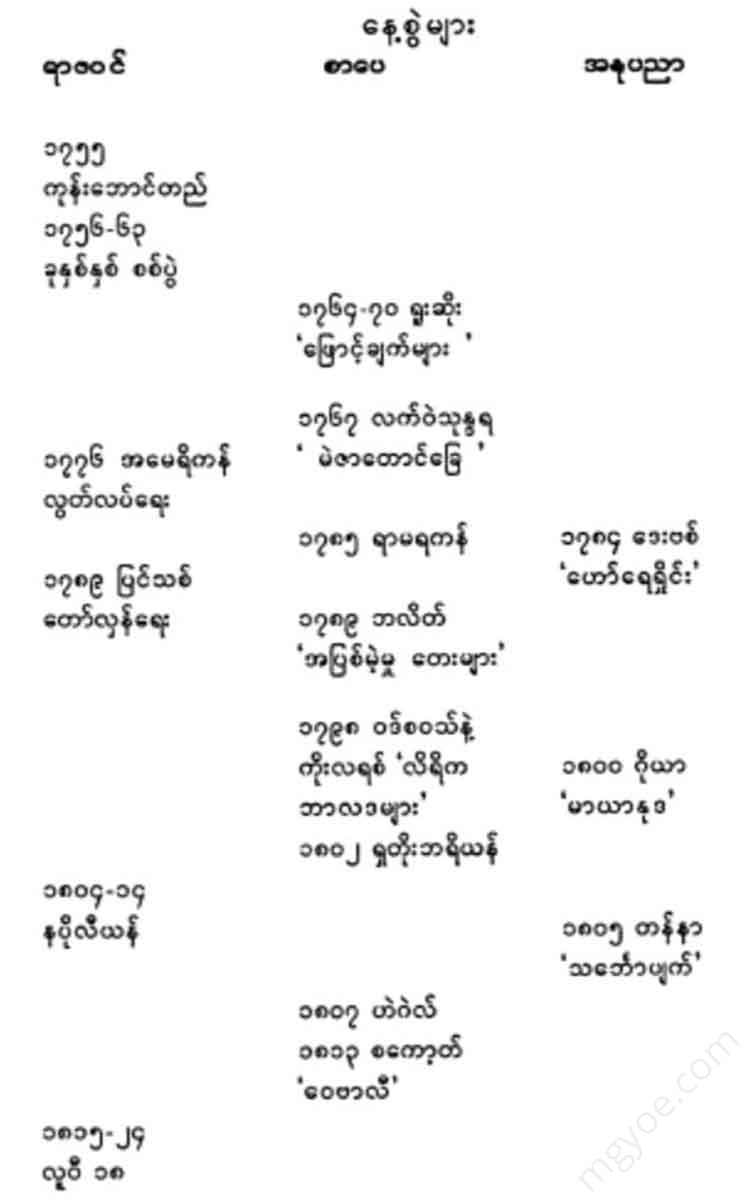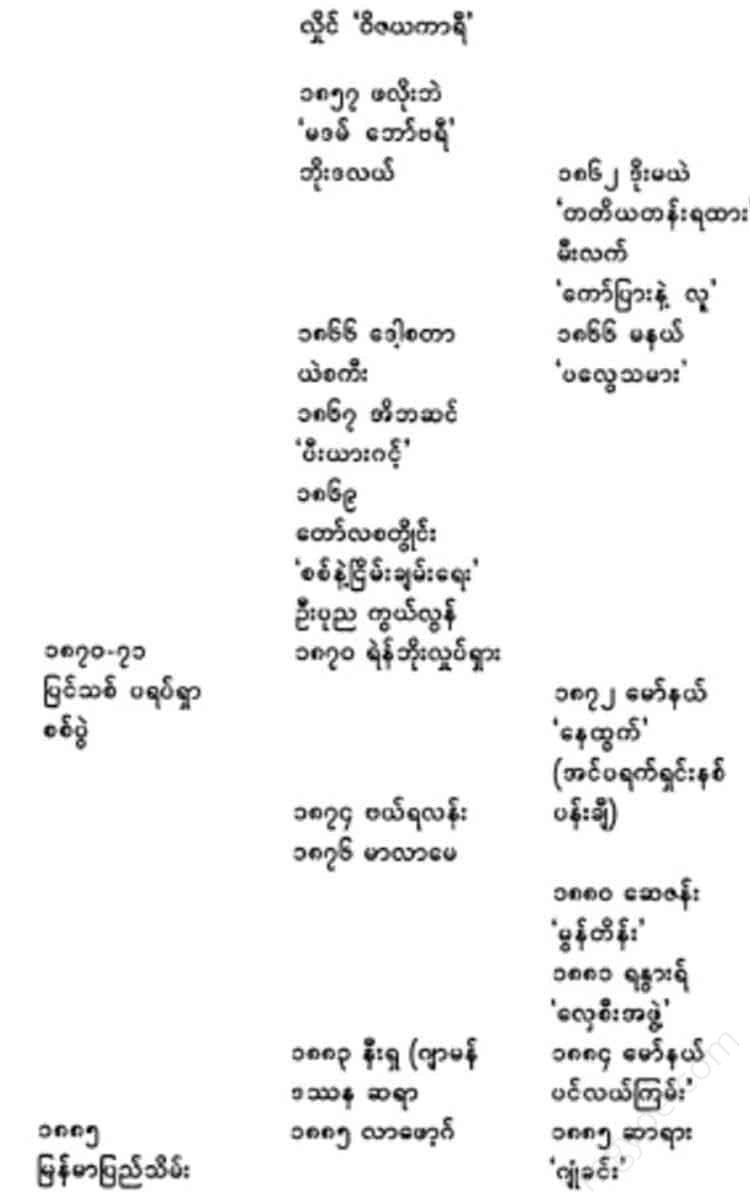Other Websites
Maung Tha No - Pine Tree Shade
Maung Tha No - Pine Tree Shade
Couldn't load pickup availability
(1)
Western poetry
"Sein Chu Kyar Nyaung" and "Communist Manifesto"
Fifteen years ago, the author, accompanied by a foreign journalist, visited the home of a Burmese painter. He was a fairly well-known painter. As they talked about painting, the foreign friend asked, “What kind of trends are you currently seeing?” My painter friend could not understand his question and became confused.
I came in and said, “Oh, we don’t have many styles, sir. We’re just drawing in the traditional way.” There may be artists in Myanmar who have studied contemporary art styles from that time period before they were modern. But many, like my friend, are just drawing people, landscapes, watercolors, and oil paintings with the same techniques they learned. It’s not long ago that the art world heard the words “modern art,” “realism,” and “impressionism.”
But here the Burmese art world is more fortunate than the Burmese literature world. Nowadays, modern Burmese paintings are emerging, and even the porter is already quite advanced, but there is no reason to be drunk with the name “modern” Burmese poetry. Yes, we Aung Chein no longer write a complete poem like Letwe Sundara, and we O Aung Ha do not strive to make a poem magnificent by searching for the best of the ten great dramas like Shin Maha Rathasara. But the subject matter is becoming wider, more diverse, and new styles are emerging (is it new or not), and the “sensitivity” that permeates literature is not only thin but also thin. (See the attached table) Today, we are trying to keep up with the times in all aspects. We have caught up with the times to some extent. But there are still many who are lagging behind. Among all this, literature is running at the top. So what should we do? We must try, we must study. By studying the level of others, we will also see our own level and situation. As we see it, we will have to become more powerful and stronger. While we are being promoted as “literature for the people,” are our poems benefiting the people? If they are, to what extent are they improving? Can we not improve even more? How can we do this? We will have to examine this.
If you take a moment to pick up a history book and examine the reasons why our country has been backward in every aspect, you will find that the main reason is “isolation” or “discontinuity.” While others are building huge stone pillars, palaces, and temples, we are still building “thatched huts” with small trees and bamboo. While others are using steam to power large machines and vehicles, we are still “a small, laughing dodo-dong.” While others are shouting to the world that the poor have nothing to lose, only bonds to lose,” we are still “a beautiful, laughing lotus.” We still want to inherit this bad tradition of “discontinuity” of our ancestors to this day. We, who have had much more opportunities than our ancestors, should start to eradicate this great “Burmese mentality.”
In presenting this, we want to make sure that we do not misinterpret what we mean. We are not trying to force others to follow what they are doing, or to imitate them. We are trying to understand the level at which others are doing it, the methods they are using, and what we can accept from their methods, and what we can do for ourselves, and what we should do if we do not surpass them, and then we should not fall behind, and we should be on the same level. This is what I have written in this book. I do not like all the poets I have selected in this book. If they were outstanding, and if I thought they were worth knowing, I would have included them in the list. This book has tried to introduce the poetic paths, techniques, and ideas of poets from the Western world, which is the most influential part of the world today, in a reasonable and thorough manner, and to show the "end".
2.
U Nok Toe, Shu Soe and Coleridge Western poetry has been around for as long as Western culture, or world culture, and it is not a matter of centuries, but of thousands. Therefore, even if it is called a selection of Western poetry, this little book will not be able to talk about Homer's epic poems. I have never dared to look at Shakespeare, who seems to be only the other day, and I have no intention of looking. How can civilized people study past cultures? "People should be able to talk to each other in the forest or have a long ear, but this task is taken by the "encyclopedic" scholars of the literary temple, and the thick-rimmed glasses and big human bellies of the university. This book is intended to show the way to `modern poetry' (modern poetry).
In tracing the footsteps of modern poetry, it is impossible not to mention its older brother, Romantic poetry. Therefore, this book begins with Romantic poetry. English Romantic poetry can be said to be the pioneer of Romantic poetry, so English poets occupy the front pages of this book.
There have been various attempts to translate the word "romantic" into Burmese, and I think the earliest translation would be "idealism." Some say "idealism" without "idealism." (I have used this myself.) Saya Zawgyi uses "life longing, life boredom," etc.
In a paper presented at the last research conference, I heard the term 'emotionalism' used. These terms are correct in referring to each element of Romanticism. Romanticism is both fantasy and imagination. It is also nostalgia for life, it is also boredom, and it is true that it focuses on feelings. But no one has ever covered the full meaning of this ideology. So we finally liked the proposal of U Nok Toe from Thi Pe Kula village. "Thi Pe Kula" is "Thi Pe Kula". Why are we talking about a small one-foot kula? As mentioned above, Romanticism was originally an English ideology. “The origin of the word romanticism is the fantasy genre called “Romance.” It also has meanings that have evolved from it. In the 18th century, romanticism meant a type of painting that evokes feelings of joy and nostalgia. The person who first called the literary movement that opposed classical literature “romanticism” was the German critic Friedrich Schlegel. From Germany, this term spread to England and France. The contact between these three countries led to the emergence of romanticism.
In 1750, the French writer Rousseau wrote a treatise. In the text, he wrote that man is naturally good. Progress and civilization have corrupted him. In his famous book, “Rights,” published in 1781-88, he wrote, “I am a man made unlike any other man I have ever met. I am a man made unlike any other man. I dare to believe that I am made unlike any other man. I would rather be worse. It is true that I am different from others.” This became the cry of the Romantics. That is why Rousseau is called the pre-Romantic. Rousseau’s words spread throughout Western Europe. His early writings had already spread. His ideas resonated with the feelings and emotions of the writers of that time.
At that time, the so-called Neoclassical period was the end of the era of those who wanted to preserve the ancient classical literary traditions. They were returning to folk tales and medieval fantasy. In England, folk tales were being collected extensively. In Germany, they were trying to eliminate the classical theatrical forms. They were writing new ballads based on the old ballads. However, one of the leaders, Git Te himself, was a return to classicism, and although there were some Romantics in Germany, they did not succeed. The real Romanticism came to England. In England, Romantics had been appearing for about fifty years. However, the official time of the purification of Romanticism was 1798, with the publication of Wadsworth and Coleridge's 'Lyrical Ballads'. The preface to the second edition of this book (1800) is called the 'Manifesto of Romanticism'. At that time, Coleridge had spent some time in Germany. Wadsworth had also visited France before the Revolution. He had come to criticize the revolutionary ideas of the Germans and many English writers. This criticism led to the rise of Romanticism in England. But it was only a few years after its appearance in England that Romanticism emerged in Germany. Well... In the homeland of the person who first sowed the seeds of this ideology (France), it was much later. It took a long time to cultivate it. The neoclassical planet could not be separated from it.
